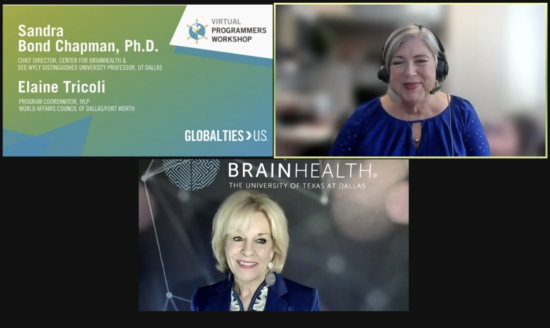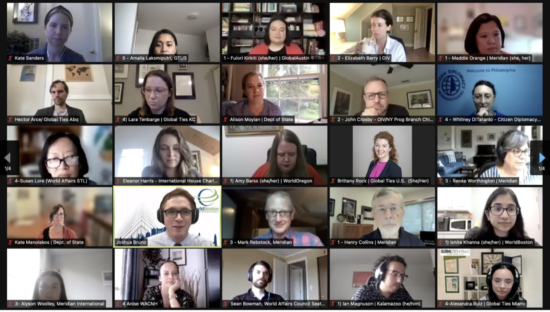By Amalia Laksmiputri, Events Intern, and Carla Picasso, Communications Intern, Global Ties U.S.
From September 21 – 23, 2021, Global Ties U.S. hosted the Virtual Programmers Workshop: Return to In-Person Programming. The three-day workshop convened more than 170 representatives from Community-Based Members, National Program Agencies, and the U.S. Department of State’s Office of International Visitors for dynamic and collaborative conversations on the silver linings of virtual projects during the pandemic and preparing to return to in-person programming.
Visit the Member Corner for resources and recorded sessions (member login required).
Flexibility and Creativity as Invaluable Assets
The pandemic has brought unprecedented challenges for the Global Ties Network, which centers itself on building people-to-people connections through exchanges like the International Visitor Leadership Program (IVLP). While there’s no replacement for in-person exchange programming, since March 2020, the Global Ties Network has innovated and adapted their work to the virtual environment. In the past year, the Global Ties Network organized almost 300 exchange projects and activities for more than 4,700 participants.
Anne Grimes, Director of the Office of International Visitors, shared at the opening session of the Virtual Programmers Workshop, “Not only have you transitioned to an entire new world, the virtual program, in a relatively short time, but you did so while your own lives and communities are in transition, and in some cases, upended. Thank you for sticking with this, and for believing in the power of exchange, no matter what form or shape.”
Attendees at the Virtual Programmers Workshop discussed how programmers have to be flexible and creative in establishing relationships and connections in ways they have never done before to replicate the impact in a virtual setting. For instance, one programmer shared how “…in Texas, we did [virtual] line dancing to get their bodies moving.” Specific conversations focused on ways to get creative with meeting formats, engage local partners, and brainstorm new tools and platforms to incorporate participants before, during, and after an exchange.
A partner at the U.S. Department of State noted that “To make programs shine, each programmer has to bring their best game. Be flexible, resilient, and change the program to fit this new world we live in.” Exchange partners also highlighted the importance of asking questions that are not often asked, conducting in-person meetings in new locations, and converting in-person meeting spaces to support hybrid and virtual programming. As the Network works towards a return to in-person programming, we can continue to incorporate and adapt the best of virtual programming. It will not be easy, but as we’ve seen since March 2020, our Network is flexible, creative, and able to innovate.
An Opportunity for Accessibility, Diversity, and Inclusion
Virtual exchange enables programs to be more accessible, diverse, and inclusive, as it provides opportunities to reach a wider audience and new participants. Throughout the Virtual Programmers Workshop, participants expressed how they are leveraging virtual exchange to create more inclusive programming. For instance, attendees shared how they’re innovating elements of cultural exchange, such as virtual museum tours. Participants also discussed how they are organizing cross-city panels with other Community-Based Members, and engaging new audiences who were previously unable to travel due to financial, time, geographic, and other logistical barriers. A North Carolina partner stated: “Even though we didn’t send [our speakers] a plane ticket and have them fly over for our speaker series, we were able to engage them and use their knowledge because of the virtual option, because we’re living in this Zoom world.”
Through multiple virtual breakout rooms, participants were able to connect on how diversity, equity, and inclusion could be implemented through IVLP programs. Many explained that ensuring a diverse group of panelists from a wide variety of international groups and local partners makes an important impact. As one participant noted, “Finding the link, the connection between the participants with the local touches will create a certain bond. For example, we connected Ukrainian participants with the Ukrainian-American diaspora community.” Added another participant, “Diversity is not just about race, but economically, politically, geographically and we should get that diversity captured during the storytelling.” Diversifying host community and home hospitality, exposing the exchange participants to the variety of opinions and perspectives in the United States are some of the impacts behind virtual cultural exchanges.
Global Ties U.S., President and CEO Katherine Brown, Ph.D., shared her thoughts, “Our mission for this work is to better understand challenges and opportunities within our Network for diversity, equity, and inclusion work, and build professional development opportunities.”
Keynote Address – The Key to a Resilient Brain

Sandra Bond Chapman, Ph.D., Chief Director of the Center for BrainHealth at the University of Texas at Dallas, delivered the keynote address, which discussed the intersection of brain health and social connection. In conversation with Elaine Tricoli of the World Affairs Council of Dallas/Fort Worth, Sandra explained the mental challenges posed by the pandemic and how our brain responded to social isolation and uncertainty.
Sandra discussed how social connection is the brain’s greatest driver, especially by meeting different people. She explained that the best fuel for a resilient brain includes two aspects: social connectedness through meaningful interactions and establishing a purpose in life, and shared the following suggestions to strengthen our mental resilience as we move forward:
- Brain power of less – Take much less information and then do more with that little information.
- Brain power of none – Let your brain take a break five times a day, for five minutes each allowing your brain to reset.
- Brain power of one – Focus on doing one thing at a time, not multitasking. Doing two or more activities that require cognitive effort at the same time, fray the neural connections in our brain and increase the primary stress hormone.
This keynote event allowed the Network to reflect on their personal connections throughout the week and how this positively impacted their brain’s health. As Sandra noted, “Every person is a cognitive puzzle, so to be socially isolated is devastating.” She ended by saying, “You are the architect of your brain, our brain changes, adapted after every interaction. So, what kind of brain would that be?”
The three-day Virtual Programmers Workshop engaged International Visitor Leadership Program (IVLP) partners in conversations on best practices of virtual programming, in-person programming procedure and readiness, as well as recommendations on how to empower programmers, future participants and the community as a whole. Global Ties U.S. introduced the Virtual Programmers Workshop as a way to continue Global Ties Network learning opportunities during the pandemic in implementing IVLP projects, both virtually and in-person.

